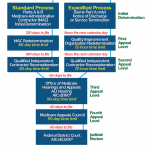Zone Program Integrity Contractors (ZPICs)
Mr. Liles said aggressive ZPIC enforcement actions—which are on the rise—may represent a far greater threat to the ongoing viability of a rheumatologist’s practice than a postpayment audit or a mere overpayment demand. ZPICs conduct unannounced site visits designed to identify coding and billing deficiencies, as well as business-related violations, Liles said. Increasingly, ZPICs have been placing providers on prepayment review, which requires the provider to submit all supporting documentation for assessment before a claim is paid. “Prepayment reviews can prove disastrous for physicians with a high Medicare patient population,” he said, adding that a prepayment review can remain in place for six months to a year and lead to serious cash flow problems while claims are being assessed by the ZPIC. “In some instances, being placed on prepayment review can lead to bankruptcy,” he added.
Another concern is the use of postpayment audits in which a ZPIC takes a representative sample of the provider’s claims and then extrapolates any overpayment identified to all claims. He said this could result in enormous alleged damages that must be appealed by the provider.
Final Thoughts
Liles emphasized the need to take claims, reviews, and audits from Medicare and private payers seriously. He also reiterated the importance of developing, implementing, and adhering to provisions in an effective compliance plan, one that is tailored to the needs and specific risks faced by one’s own organization. He recommended against using a “cookie cutter” compliance plan developed by others, or one that can be downloaded from the Internet. As Liles noted, “your compliance plan should be a reflection of your particular practice, and should serve as a road map for staying within the four corners of the law.”
Mary Beth Nierengarten is a freelance medical journalist based in St. Paul, Minn.
Ten Easy Steps to Improve Your Compliance
- Screen your employees. Have they been excluded from participation in the Medicare or Medicaid programs?
- Verify licenses, degrees, and certificates. Are they up to date? Is the individual’s license restricted in any way?
- Conduct a preliminary HIPAA audit. What steps must you take to reduce the possibility of a breach?
- Read your contracts. What are your obligations and your rights under each contract?
- Pull a list of claims billed in the last 90 days and examine the top three most frequent types of claims billed to see if your physicians are complying with applicable evaluation and management (E/M) requirements. Read and understand the 1995 and 1997 E/M guidelines published by the federal Health Care Financing Administration (HCFA).
- Review prior claim denials and determine why claims have been denied. Are the denials a one-time error, or do they represent a larger problem?
- Educate staff and ensure they are all qualified to do their jobs. Train, train, train!
- Adopt an honor code. Liles recommends a version of the honor code used by Texas A&M University. “Our practice and staff do not lie, cheat, steal, or tolerate those who do.”
- Set up an anonymous complaint line or e-mail address. Give patients and employees an opportunity to bring problems to your attention without the fear of retaliation.
- Develop and implement an effective compliance plan. Liles compared a compliance plan to a flu shot: you can still develop the flu after a flu shot, but hopefully vaccination reduces the severity. A compliance plan may not protect against all mistakes, but is likely to help reduce the seriousness of ones made.


